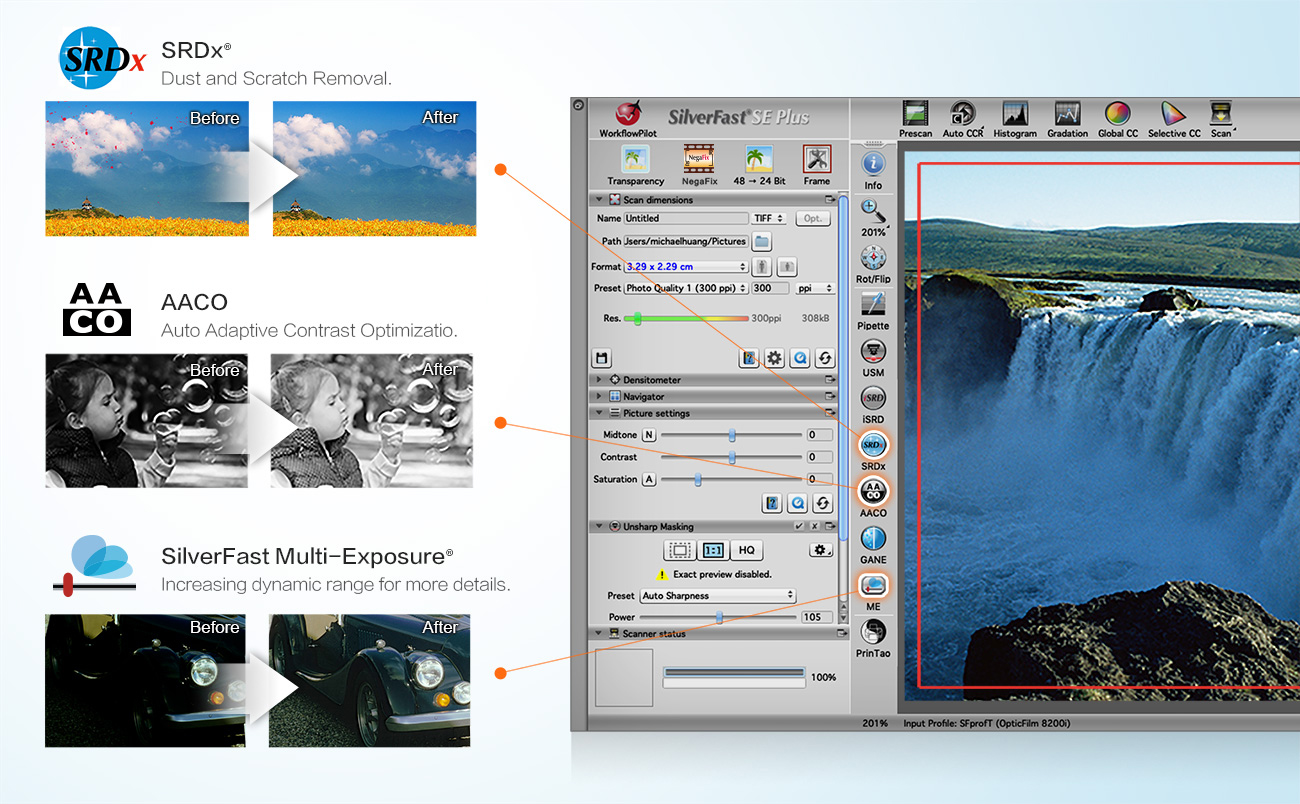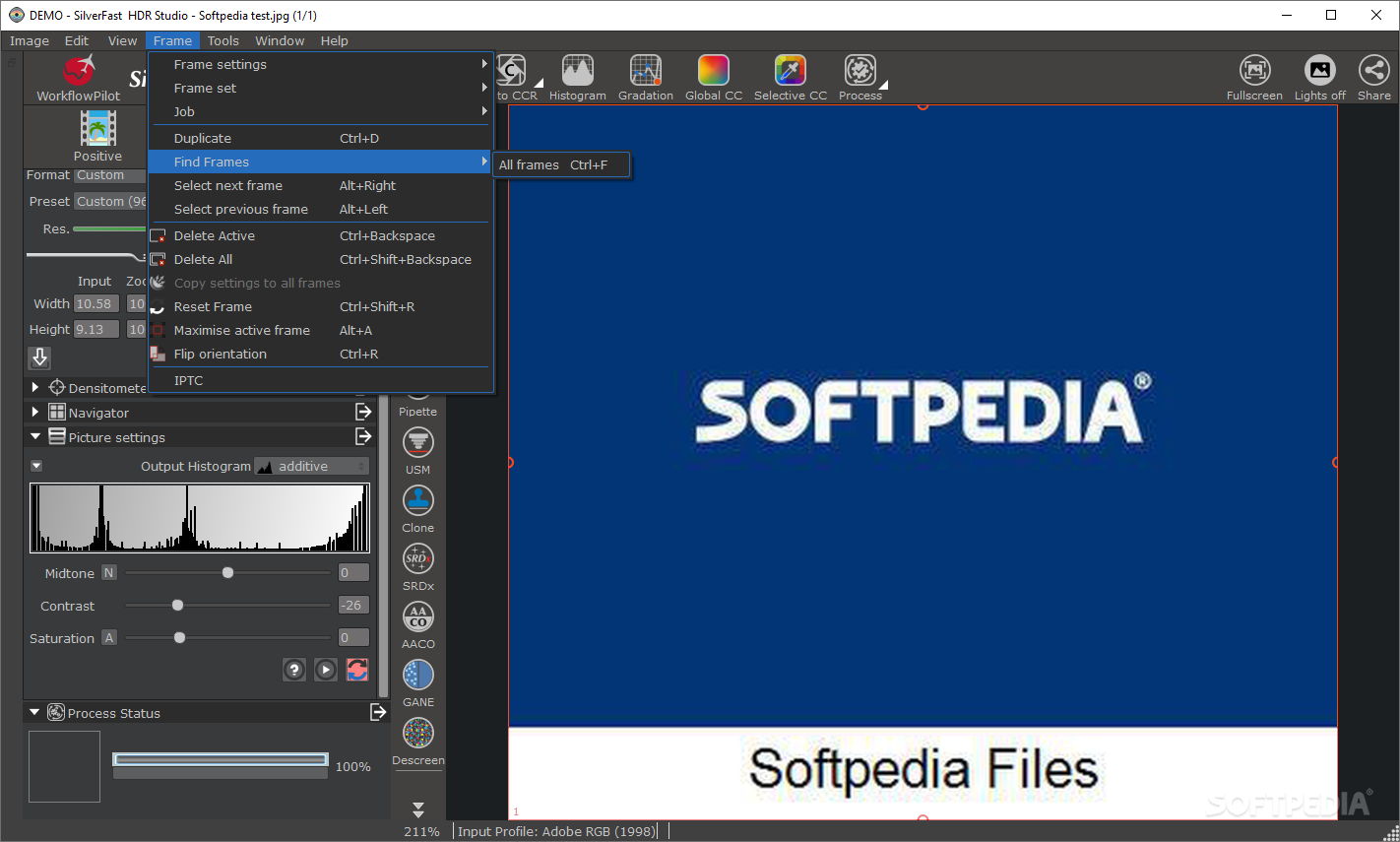SilverFast HDR is an image-processing app that incorporates all important color reproduction and color management tools. This makes SilverFast HDR a real alternative to Adobe Photoshop and Lightroom. It offers tools for automatic image optimization and color-cast removal. You can easily adapt individual colors or the overall color impression. Tools for image sharpening and removal of defects make the HDR software a performance all-rounder.
Features
- Color reproduction and management
- Non-destructive image optimization
- Multiple processings without loss of quality
- Constant maximum bit depth and information
- SRDx, JobManager
- iPhone app, SilverFast JobMonitor
As an integral part of the SilverFast RAW data concept, SilverFast offers optimal quality from end-to-end. You workflow is lossless and non-destructive, with full bit-depth at all times, keeping your original images untouched and providing you the option to return them to their initial state. Instead of processing your images over-and-over with each tool, SilverFast stores your optimizations during the initial edit. They are then applied in an optimal sequence during final processing. Thus, you don't have to worry about the right sequence for the application of the tools.
Scanning Workflows With SilverFast 8 – SilverFast HDR To date, the only comprehensive resource of its kind, available for purchase on the PhotoPXL website: This book is for anyone seeking to learn efficient workflows for scanning film media and maximizing image quality from scanned media, whether positive transparencies or color/B&W negatives.
Hi.- It describes the use of SilverFast 8 and SilverFast HDR 8 either as stand-alone applications or used in carefully documented workflows including Adobe Photoshop or Adobe Photoshop Lightroom. It addresses in detail the perennial question of “What do I do Where”. SilverFast Scanning Book Index 1.
- Silverfast 8 HDR Review. Just outta beta. In Product reviews, Friday, October 12, 2012. A couple of weeks ago, Silverfast 8 HDR finally, quietly slipped out of Beta. I’ve been using it for a few weeks now, so it’s time for a quick review.
- In SilverFast HDR, the JobManager is even more effective. Any number of previously scanned RAW image files can be optimized in batch mode automatically one after the other.
 I'm sorry if this has been answered before. I couldn't find any place where straight answers to my questions were available.
I'm sorry if this has been answered before. I couldn't find any place where straight answers to my questions were available.I have AI Studio (AFL, Reflecta RPS 7200) plus HDR Studio. From what I've understood, my best possible workflow for negative archival would be:
- scan to 64-bit HDRi
 - with maximum optical resolution
- with maximum optical resolution- write as many EXIF data as I'll want later on


- no cropping (it's a film scanner processing a 24.3 x 36.5 mm area at a time)
- no corrections
- open the scans in HDR Studio someday, do all processing and save the result to printable files
My questions are:
Lasersoft Imaging Silverfast
- At what point should I apply negafix? My instinct is that the correct procedure would be to scan as positive, and only apply negafix within HDR Studio. But I wonder if the correct selection of negafix before scanning wouldn't help the scanning process? I'm unaware of the specifics of the scanning; whether Silverfast operates the scanner in different ways or not according to whether it's in positive or negative mode, for instance. In particular, I'm worried that scanning a negative in positive mode is somehow sub-optimal (because of the orange mask, if nothing else). But maybe this is a completely wrong idea. I've also heard about scanning with 'linear' negafix, is that what I should do? And only later apply the right negafix within HDR Studio?- Do I lose anything by applying iSRD only in HDR Studio? I know that the great part of ICE is that the scanner reads the IR data and so is aware of where the dust and scratches are. What I'm wondering is whether there is any other part of the iSRD process that depends on hardware and has to be done during the scan, and can only be approximated if done by software later on. I'm assuming no - that reading the IR channel first and applying iSRD later on gives equal (or better, if the algorithms improve with time) results to simply applying iSRD during the scan time.
- Speaking of iSRD, I've heard that Photoshop CS5 will have very improved scratch-removal algorithms. Is there any chance similar algorithms (if they exist) can be implemented in Silverfast, or that Photoshop can be made IR-aware, to apply them to files produced by HDR Studio?
Silverfast 9
- Is there any tool to edit EXIF data in a file? I mean, I'd like to the file not to be changed, only the EXIF data. Imagine if I had forgotten something in the scannign step, would there be a way to add it later on without any extra processing?- I've heard that EXIF data is not always well-interpreted by programs and some may even 'read' it as noise into the image. Should I worry about that? EXIF is not vital to me - it's just that I'm thinking that I intend to scan each image only one, but may process it multiple times in HDR Studio - and inputting EXIF right into the original scan would propagate it easily into any derived image (I suppose).
- Will I have any problem because of scanning the whole scanner area (24.3 x 36.5 mm) with no cropping? I know that image-processing algorithms only work OK if only the usable parts of the image are used. But since I intend to do all processing in HDR Studio, I can *then* process a usable crop of the image. In those conditions, would I have any problem in doing the scan with the whole area, film borders included? IINM, other programs have an option to 'ignore' a certain margin of the frame when applying image algorithms (say, they'll only use 23x35 mm to do the calculations, and then they apply the treatment to the whole 24x36). Does Silverfast consider having a similar option? Maybe the drawable frame border could include a shaded inset to indicate the margin that wouldn't be considered for calculations.
I'm sorry for all these questions, but I couldn't find definite answers for them.
Thank you very much,
Silverfast Hdr Studio
Antonio